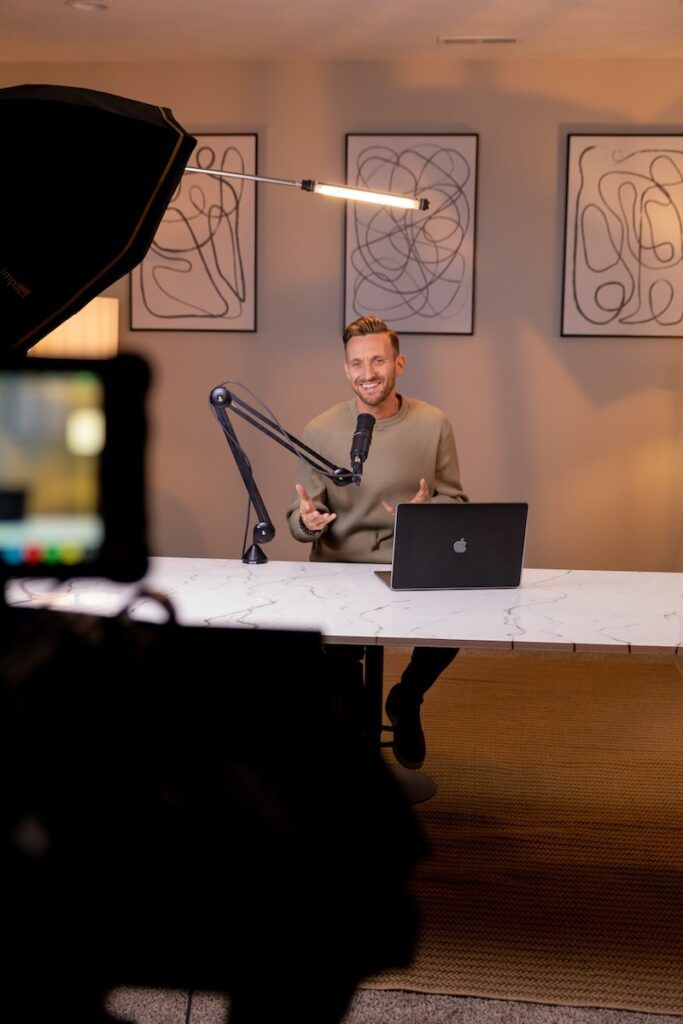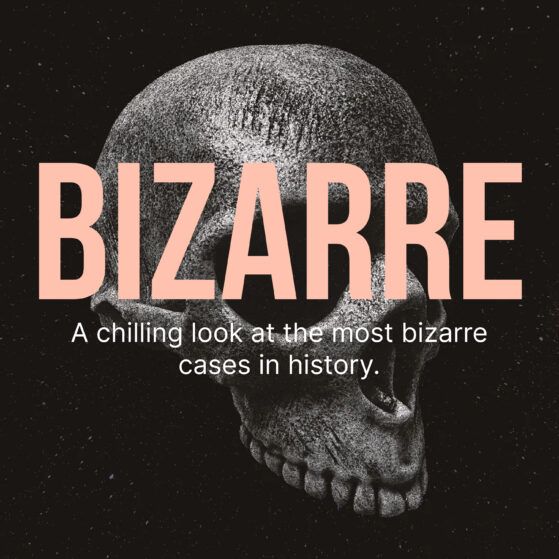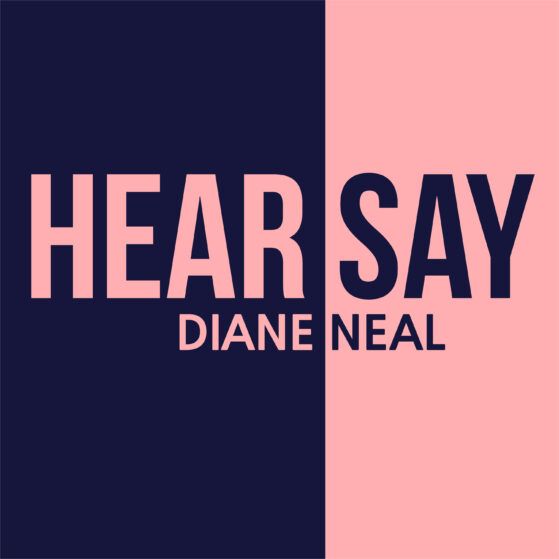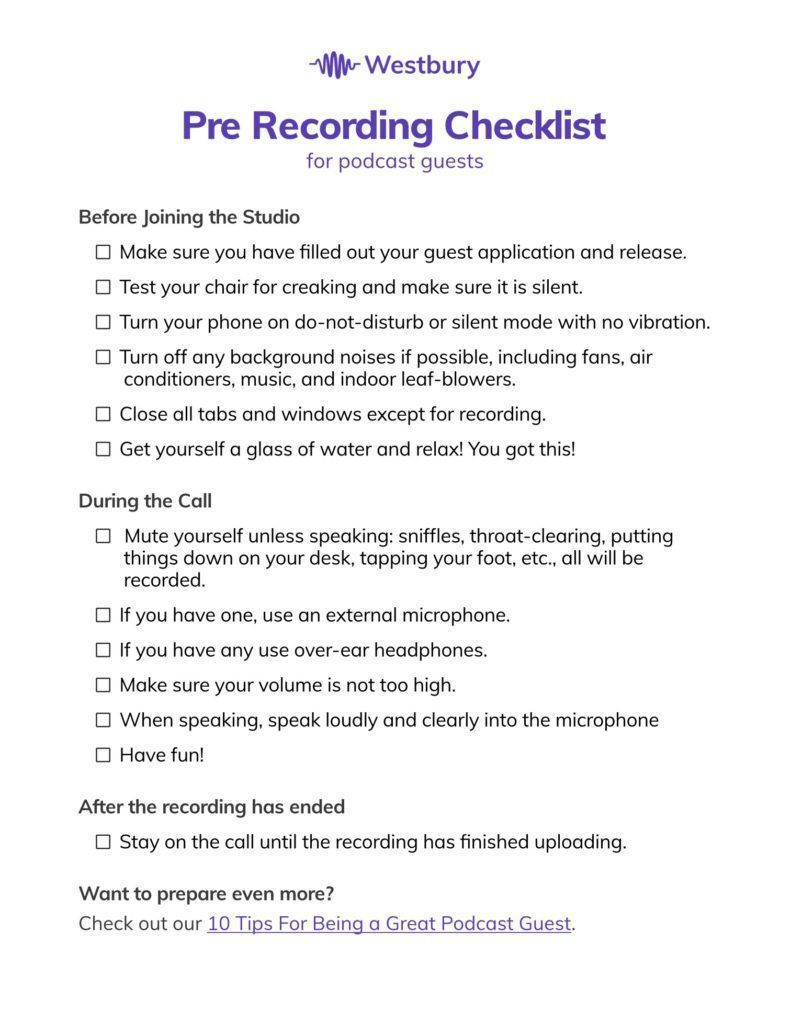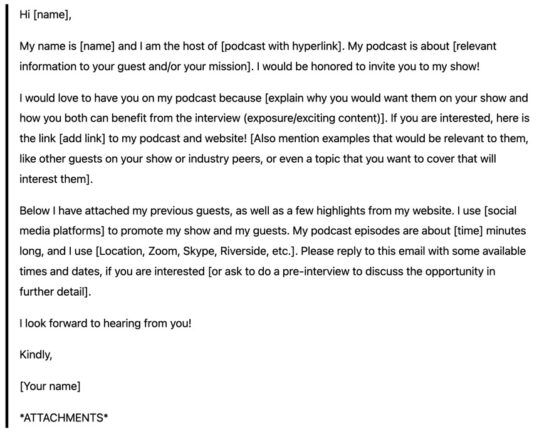Quick answer: Generally there are 4 different podcast table setups you can choose from — 1. News Style, 2. Roundtable, 3. Kitchen table style, and 4. Coffee table style. Read on to learn more about the benefits and drawbacks of each.
Have you ever watched a video podcast on social media and found it difficult to focus on the content because the table and equipment were distracting or disorganized? If not, it’s because, like podcasts with poor sound quality, podcasts with this problem don’t tend to do well with their target audience.
And unfortunately, as silly as it may seem, this is a common problem for podcasters, but it can be easily solved with a good podcast table. A distracting or disorganized table can ruin the viewing experience, and a messy podcast setup can make it hard for podcast listeners of your target audience to engage with the content coming out of your podcasting studio. This can lead to lower viewership and a negative impact on the success of the podcast.
That’s why today we’ll be exploring the key elements of a great podcast table, popular podcast table ideas, and how to choose the right podcast table for your video podcast.
Benefits of a Good Podcast Table
Helps your show grow
Having a more engaged audience is key to the success of a podcast episode, and video is a great way to engage your existing audience. It’s also a great way to reach more listeners, breaking the ceiling of being just an apple podcast (not that we’re against being an apple podcast in addition to a video podcast).
While it may not make a big difference if you’re only planning to be an apple podcast, it’s important to have a professional podcast studio that looks clean and tidy when making a video podcast.
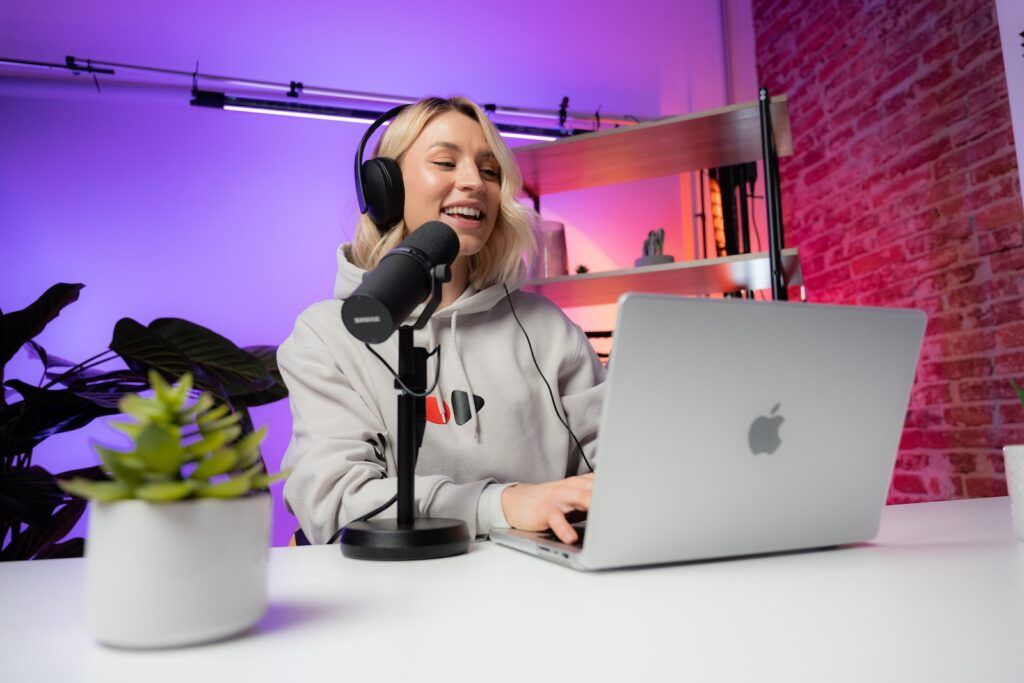
Either way, getting new podcast listeners is the name of the game, so it’s no wonder that some of the largest podcasters out there, such as Joe Rogan and Theo Von, have taken care to release video versions of each podcast episode.
What to Consider Before Choosing a Podcast Table
When setting up your podcast table, it’s important to consider the key elements that will make it stand out to your listeners.
Your Podcast Equipment
Before you consider anything else, take a look at the podcast equipment you already have. Unless you’re planning on completely remodeling your podcast studio, you’ll likely want to use most if not all of your current equipment on your new podcasting table.
Consider the number and type of microphones you have (i.e. XLR microphone or USB microphone), any acoustic panels you already own, etc. Ideally, whatever setup you go with will go with what you already own.
Next, you’ll want to consider if you may need to buy any additional equipment. For instance, if you don’t already have one, it’s a great time to buy an audio interface. It will give you the ability to have higher-end equipment, record multiple participants at once, will ensure high sound quality of your podcast than your old USB mic, and will also make things tidier on camera.
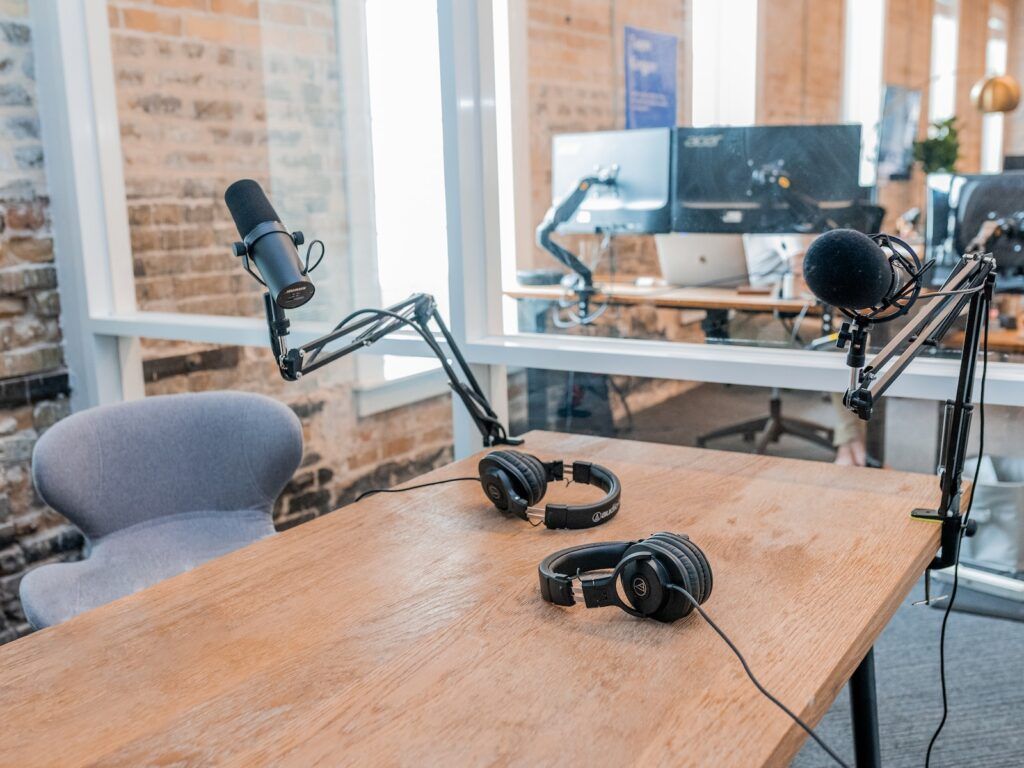
Also, consider that for each XLR microphone, you will need an XLR Cable, and the same will hold true for each USB Microphone. the number of microphones you’ll need, and the corresponding boom arm or mic stand of each one, whether your participants will be using headphones, and other podcast equipment such as acoustic panels and sound treatment. that is necessary for the podcast.
If you already have cables, consider that you may need longer ones to keep your audio interface out of view (messy wires going into an audio interface is generally not an aesthetically pleasing look).
You should also consider other types of equipment your studio and table will need outside of your microphone use a boom arm, mic stand, etc. Even your digital audio workstation can impact your studio design decisions.
Your Podcast Format
One of the most important things to consider before setting up your recording environment is your podcast format. Depending on your podcast topic, some table options might be better than others. For example, you ideally wouldn’t want to do an information-dense news-style podcast from a living room set with a coffee table, or it could give your target audience the wrong idea about how seriously you take yourself.
However, if your podcast topic is comedic in nature, or the podcast format, in general, relies on a lot of informal back and forth between each participant, a lounge environment with a coffee table might be perfect. Understanding your show’s format will help you decide what is best for your podcast studio.
Structure and Design
When it comes to the structure and design of your podcast table, it’s important to make sure it’s ergonomic, comfortable, and stylish. Choose a table that is not too high or too low, and make sure it’s wide enough to accommodate all of the necessary equipment.
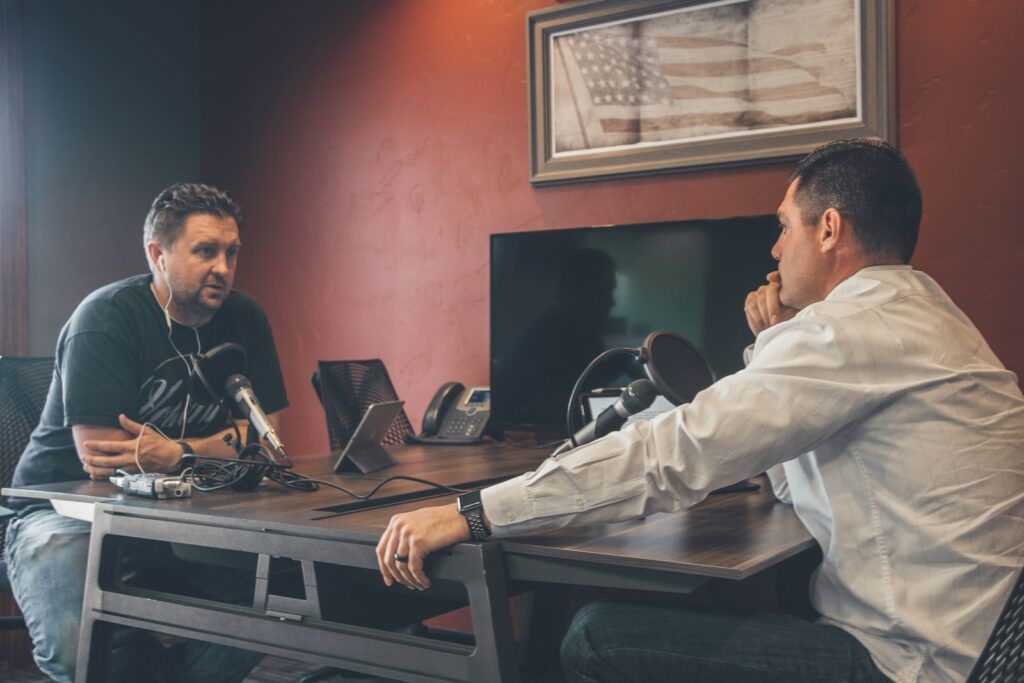
If possible, add a shelf or two to hold your audio and visual equipment, and don’t forget to add a few shelves or drawers to hold your extra materials. A stylish, modern-looking table with a sleek finish can be a great addition to your space. Finally, choose a design that fits in with the overall look and feel of your podcast.
Additionally, create a backdrop that is visually appealing and memorable. The backdrop should be simple but impactful, such as acoustic panels of your podcasting studio. If you’re able to, hang a banner or other statement piece behind the podcast table to make it more eye-catching.
Table Size and Shape
The size and shape of your table should be appropriate for your equipment and space. It should also fit your aesthetic preferences and brand image. A round or oval table typically allows for more intimate conversation and interaction between podcast hosts and guests. A rectangular or square table is ideal for more formal or professional settings. Depending on the size of your space, a small table may be enough for two to three people, while a large table can accommodate up to six people.
Also, if you’re a serious podcaster, you should consider the space the table will occupy when selecting the size and shape of your table. Will there be enough room for the podcast host?
Table Materials and Aesthetics
Podcasts are often accompanied by a visual element, so it is important to choose a podcast table that matches your aesthetic. Depending on the type of podcast you’re producing, you may want to look for a more stylish and modern table or a more vintage-inspired one.
The materials and design of your table should match the overall look and feel of your episode ideas, including your podcast equipment. This can include everything from the color and finish to the type of wood or metal used. Depending on your podcast’s theme, you might choose a modern, industrial look with a concrete or metal table, or a more traditional wooden table.
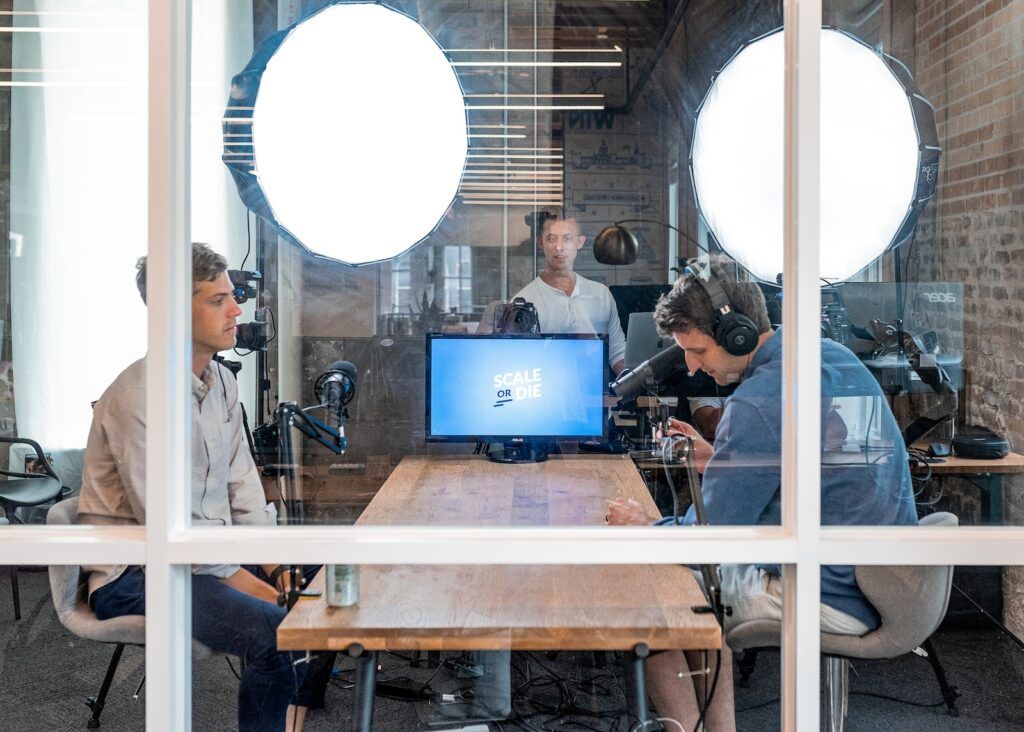
Additionally, you can decorate the table with items that match your podcast’s look, such as books, plants, or artwork. When a table matches your aesthetic it should help you think creatively, give you an idea for what each episode will feel like, and help you come up with new episode ideas altogether.
For example, if you have a book podcast, including a bookcase or shelf behind your table not only instantly signifies what you’re all about when people first see you on social media, it also provides you with an environment rice of content ideas and creativity.
Furthermore, if your podcast is about technology, you might want to include a laptop, tablet, or other tech-related items on the table. This helps your mind think about your podcast topic and could give you episode ideas.
Table Functionality
Functionality is key when it comes to creating a podcast table. You want to make sure it is sturdy and secure enough to handle your audio equipment and other items you need while recording. A great idea is to look into adding a microphone stand and other mounts to keep your equipment safe and organized.
Additionally, you may want to consider adding drawers or shelves to the podcast table for extra storage. Having a place to store extra microphones, instruments, or cables is a great way to keep your podcast setup organized. Finally, consider adding a power strip to avoid a tangled mess of cords. This way, your podcast table will be both functional and stylish.
Table Storage Space
A good podcast table should have enough storage space for your equipment, cables, and other accessories. This can help keep your table organized and free of clutter. Consider adding shelves, drawers, or a cabinet to the table for easy access.
Table Cable Management
Cable management is crucial for a clean and professional-looking podcast. A good podcast table should have built-in cable management systems to keep cables out of sight and organized. You can also look for tables with designated cable slots to make it easy to connect devices. Cable management can be a great way to make sure your podcast looks its best.
Height and Ergonomics
Your podcast table should be at the right height for your comfort and ergonomics. This can help prevent discomfort and pain associated with prolonged sitting.
Adjustability
An adjustable podcast table can help you find the perfect height and angle for your equipment and camera. This can also be useful if you have multiple hosts of different heights.
Accessibility
If you’re inviting guests to your recording studio, make sure they have access to the necessary equipment to participate. Consider adding adjustable chairs that can be lifted and lowered depending on the height of the guest. You should also make sure the microphone is placed at a height that’s comfortable for the guest to speak into.
If you’re using an audio mixer, make sure to arrange the microphone and audio mixer in a way that’s easy for the guest to reach and adjust. Also, remember to leave space for the guest to place their personal items like a water bottle or notepad. Finally, consider adding a small table lamp to provide extra lighting to the area.
When selecting a podcast table, it is important to consider the type of audio equipment you plan to use. If recording with a microphone, the table should be large enough to hold a laptop, microphone, and other audio equipment. It should also be strong and stable enough to support the weight of the equipment and any other items it will need to hold.
You’ll also want to ensure the surface is non-reflective to avoid any unwanted sounds (yes sounds) or lights reflecting off the table. Finally, the table should fit comfortably in the room and not take up too much space. With these considerations in mind, you can find the perfect podcast table to accommodate your recording needs.
Other Podcasting Needs
Your choice of podcast table should depend on your specific needs, such as the number of hosts, type of equipment, and preferred style.
If you plan on having multiple hosts, for example, you may need a larger table than if you only have one person. Additionally, the type of equipment you plan on using will determine the size and shape of the table. If your podcast requires a lot of equipment, you may want to look into a larger table that can accommodate all of it.
Consider Your Available Space: Your podcast table should fit comfortably in your available space without feeling cramped or cluttered. If you have a smaller space, opt for a simple folding table and a few smaller items like a laptop stand, microphone, and headphones. On the other hand, if you have a larger area to work with, then you may want to opt for a larger table, chairs, and additional audio equipment. Additionally, a laptop stand can be helpful to keep your laptop off the table when not in use and increase visibility for your guests.
Consider Your Budget: A good podcast table can be expensive, so it’s important to consider your budget when choosing one. There are many different types of podcast tables available, ranging from cost-effective ones that are portable and easy to store, to more expensive professional-grade models that will last for years. Research the different types of podcast tables available and determine which one is right for your budget. Additionally, look into renting podcast tables if you can’t afford to purchase one outright. This is a great way to get the setup you need without breaking the bank.
Popular Podcast Table Ideas
News Desk Style Table:
A news desk-style table can give your podcast a professional and polished look. It typically features a large, rectangular table with built-in lighting and storage. This style of podcast table is perfect for a news-style podcast, and it allows the host and guests to move around the table and interact easily.
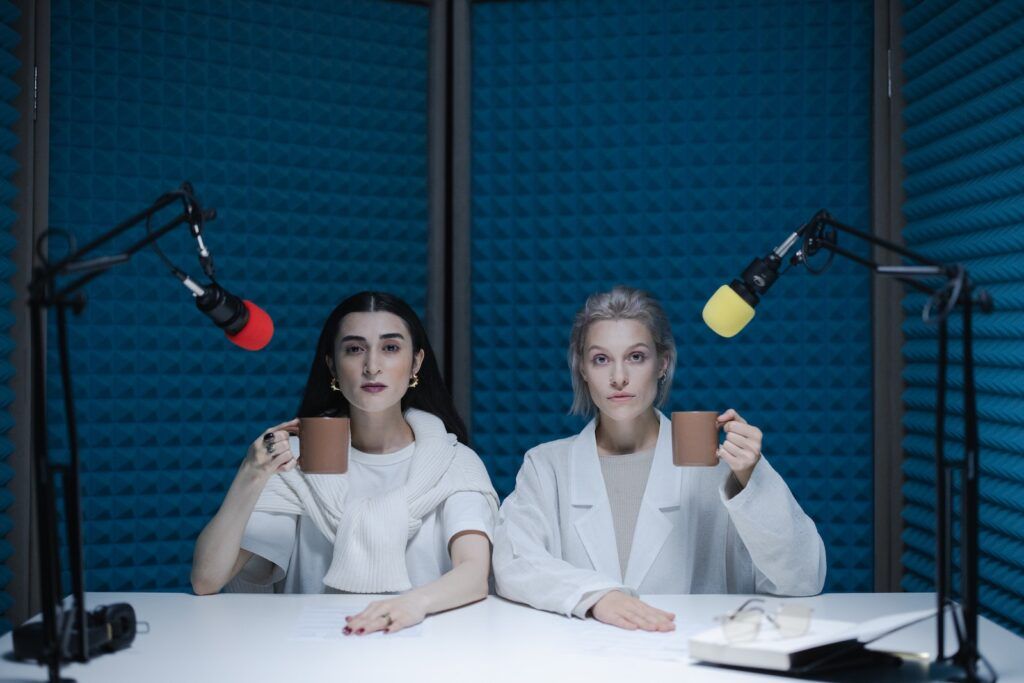
Benefits of News-Style Tables:
- Adds an air of officiality and trust to your podcast
- Creates a direct connection with the viewer by breaking the 4th wall
- Easily creates space for popups and on-screen images
- Great for creating derivative media such as vertical short videos for social media.
Drawbacks:
- Not great for interviews since it doesn’t facilitate discussion.
- Can be expensive to get right.
Types of Podcasts That Should Use This Approach:
- Informational podcasts
- Political Podcasts
- News/Satire Podcasts
Kitchen Table Style:
A kitchen table-style podcast table can add warmth and personality to your podcast. It typically features a round or rectangular table with a wood or rustic finish. The main benefit of this kind of podcast is the fact that it creates an intimate environment for discussing topics in depth and with nuance or understanding.
If you want an example of a successful podcast that uses this setup, look no further than the most successful podcast ever, The Joe Rogan Experience.
Benefits:
- Creates an intimate environment that facilitates deep conversation
- Great for interviews because it encourages positive conversation between participants
- Great format for multiple guests
Drawbacks:
- Not great for one-person podcasts
- Doesn’t include audience in conversation, keeps the 4th wall
Roundtable Style
A roundtable-style podcast table can benefit any podcast idea that leans on formal group discussions. If your podcast production goals include content ideas such as current topics, multiple professionals or create a more inclusive atmosphere for your podcast. It typically features a half-moon shaped table with a simple or elegant design.
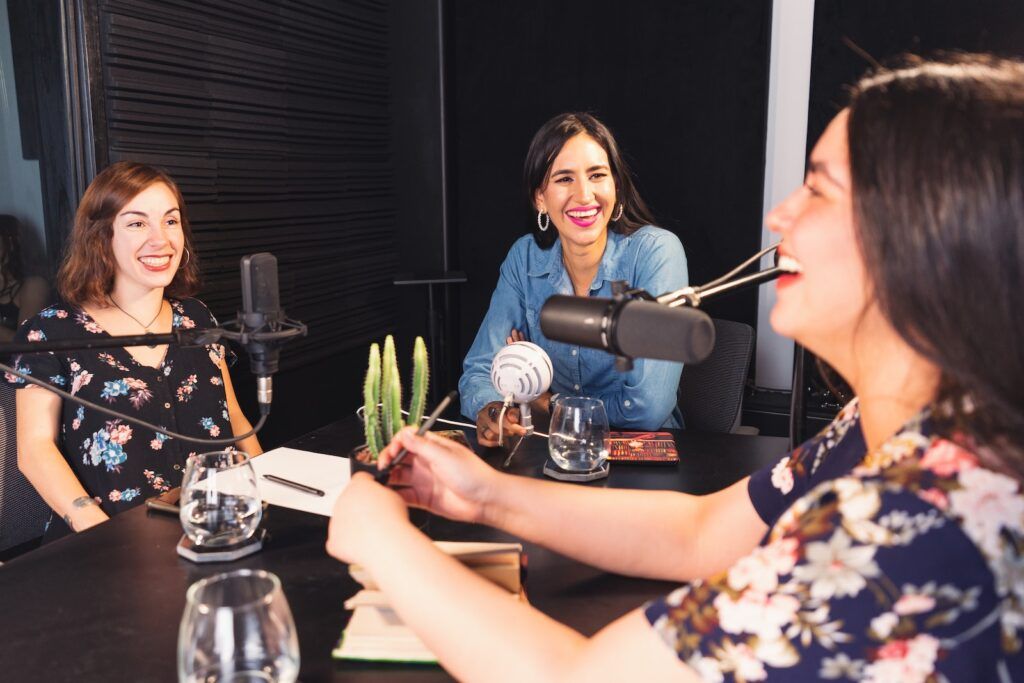
Benefits:
- Great mix between the kitchen-table and news-desk style podcasts
- Great visibility of all participants from master angle
Drawbacks:
- Can make look too staged
- Less intimate than a kitchen table style
- Can make participants feel “in the spotlight”
- Expensive to build
Coffee Table
This is an ideal setup for those who have content ideas that benefit from a casual atmosphere. A small round table with two chairs is a classic option. If you want to spice it up a bit, consider adding a plant or a few pillows to make it feel homey. If you want to take it up a notch, add a colorful tablecloth or throw rug to make it stand out. You can also add a few books or magazines to give it a more polished look.
Benefits:
- Creates very casual, comfortable atmosphere
- Great for group conversations
Drawbacks:
- Can be too informal for a serious or informational podcast episode.
- Can become cluttered quickly, giving podcast listeners anxiety.
- Can look low budget
Type of podcasts this is good for:
- Comedy podcasts
- Interview podcasts
- Talk shows
Summary & What to Consider Next
A good podcast table should have the right structure and design, functionality, and accessibility. It should also include various audio equipment, as well as storage and seating options.
Podcast tables come in a variety of shapes, sizes, and styles, and can be made with a variety of materials. It’s important to consider the functionality, accessibility, and the right equipment in order to make the most of a podcast table. The right table can improve the overall sound quality, help keep the podcast organized, and provide an aesthetic appeal to the podcast.
A good podcast table can help create a professional and engaging viewing experience, while a bad one can be distracting and off-putting. A quality podcast table with plenty of sound treatment should minimize background noise in any recording studio, provide a sturdy surface for equipment, and be adjustable for height and width.
Additionally, a good table should provide adequate space for monitors and other equipment, as well as allow for easy access to audio/visual cables, jacks, and other connections. Finally, a good table should be easy to move around or reconfigure, allowing you to quickly set up and break down your podcasting studio.
There are many podcast table ideas out there, so don’t be afraid to experiment and try out something new. Have a brainstorming session with your team and come up with some fun and creative ideas. For example, you could incorporate elements such as fun props and decorations to make the table look more interesting or have a specific theme for each episode.
You could also create a “podcast swag” section with T-shirts, mugs, and other items that people can purchase. Try to think outside the box and come up with something unique for your podcast table!

